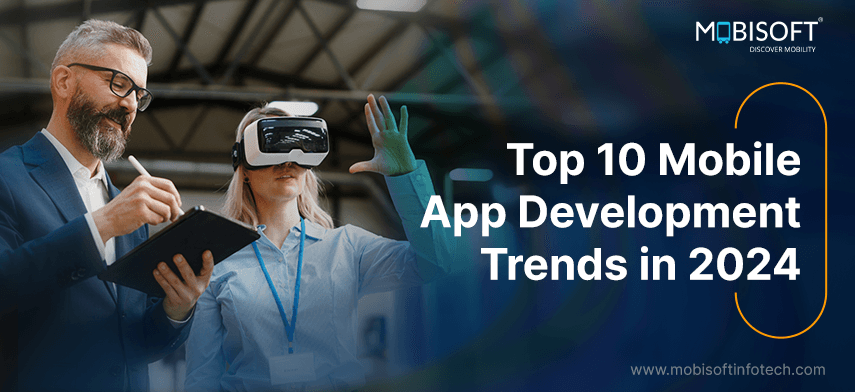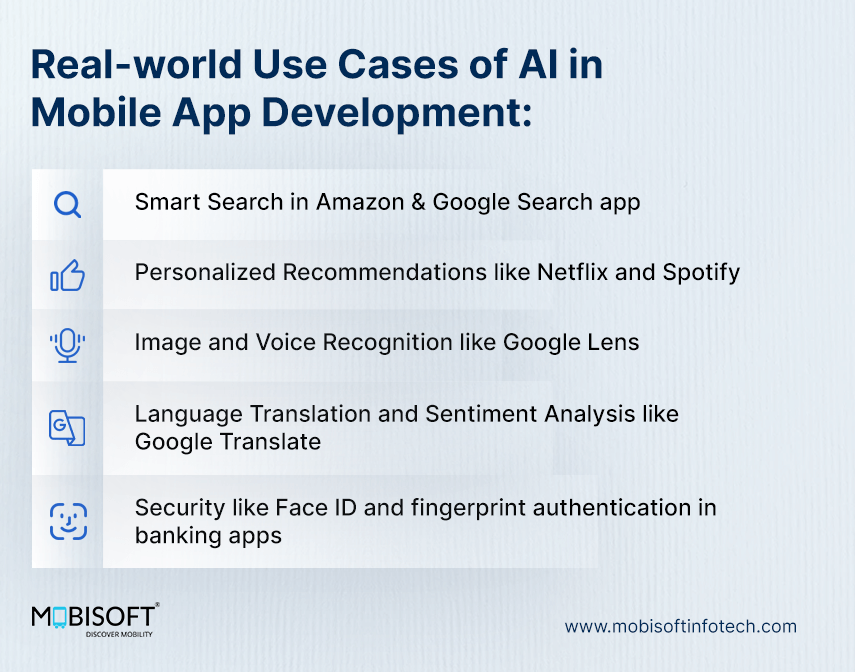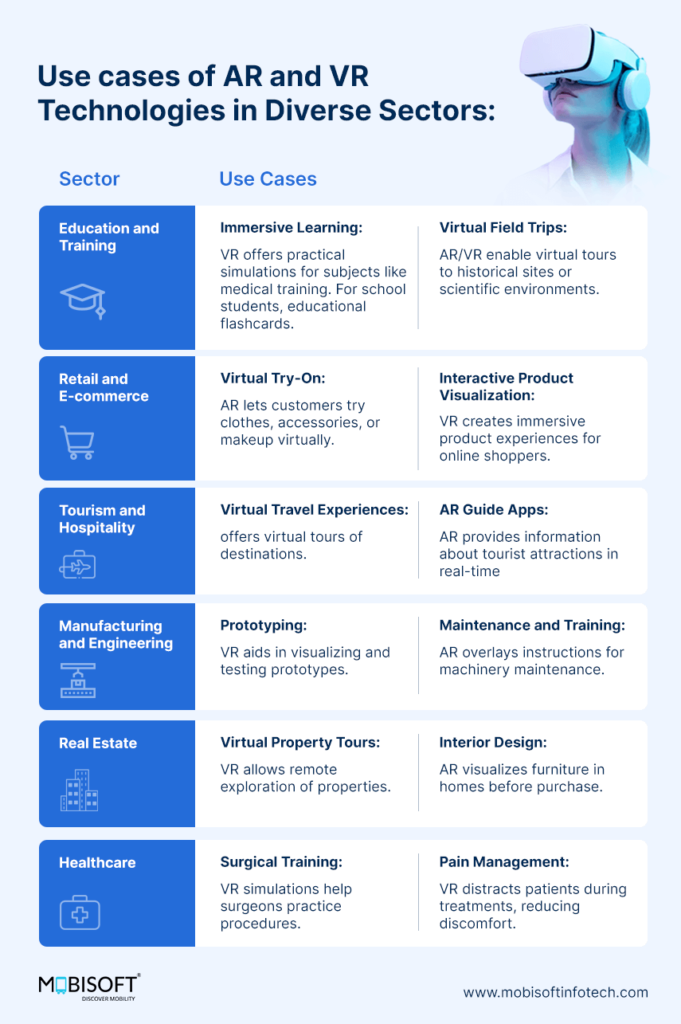Mobile apps have become the new frontier today, promising direct consumer interactions, personalized experiences, and increased business productivity. With approx 8 million apps flooding iOS and Android platforms, the mobile app development industry continues surging with no signs of stopping in the near future.

The revenue generated from mobile apps is staggering and is about to hit US $673.80bn by 2027. A report by Statista predicts that global app spending will exceed $53 billion by 2024, resulting in $541.1 billion in revenue. With all that potential growth and revenue comes massive opportunities for businesses.
Furthermore, the rise of new development tools, frameworks, platforms, and evolving user preferences has democratized the entire mobile app development process, encouraging appreneurs and mobile app developers to create user-centric applications. This necessitates keeping up to date with the latest mobile app development trends that will continue the pace of business growth in the coming years. Dive in with us and discover what the future holds!
Top 10 Mobile App Development Trends to Dominate the Market in 2024
In recent times, there has been an increasing trend towards developing innovative apps that cater to specific use cases. This has encouraged professionals such as CIOs, mobile app developers, programmers, engineers, and UI/UX designers to create more striking, targeted mobile apps, compelling them to adapt to the following top trends to rule 2024.
Trend 1: AI-powered User Interfaces for Hyper-personalization and Micro-interactions
According to 84% of consumers, being treated like a person is more significant instead of being treated like a number. They (91%) are 2.1 times more likely to consider personalized offers. Additionally, 70% of them believe that a company’s understanding of their personal needs directly impacts their loyalty. These findings emphasize the value of personalization in building strong customer relationships. Mobile app developers can achieve this level of personalization by leveraging a combination of AI-powered tools, recommendation engines, neural networks, and machine-learning algorithms.
AI has been in trend since 2023 as it can provide precise insights and reduce much of the work of humans. Developers can employ a whole new range of AI-powered capabilities that provide various types of user data with unparalleled accuracy such as users’ intuition, needs, preferences, patterns, feedback, and other behavioral aspects to:
- Tailor mobile app content
- Deliver highly accurate recommendations, guided flow
- Refine app functionalities and add flashy features
- Respond to each user’s interest
- Create adaptable user interfaces
- Ensure a more satisfying user journey

AI’s potential is vast and a seismic shift in AI investment is expected to ramp up in 2024. It was US$60 last year and is predicted to reach US$200 by 2030. Just imagine the growth trajectory! Additionally, the Artificial Intelligence market size is expected to reach a whopping US$738.80bn by 2030.
This skyrocketing AI investment is centered around companies that:
- Provide infrastructure like data centers for AI applications
- Train and develop AI models
- Develop software for AI-enabled applications
As we all know Apple is quietly an AI giant, investing as well as acquiring dozens of AI startups to elevate their users’ micro-interactions on multiple devices. Similarly, other brands have also increased their AI adoption in their app development initiatives with much vigor to automate repetitive tasks, enable intelligent testing, facilitate streamlined collaboration among teams, and gain lasting value.
In 2024, expect mobile apps that learn and adapt to user behaviors and shifting market dynamics, offering hyper-personalized experiences across the touchpoints. This is possible with Artificial Intelligence technology adoption only.
How to Leverage this Trend?
The alignment of technologies involved in mobile application development, people, and processes requires a holistic approach to AI adoption. So, find your own mix of strategies with the help of AI technology consultants that enable the greatest value AI has to offer.
Trend 2: Cross-platform Development to Redefine the App Creation
In the coming years, the cross platform app development trend is expected to continue its upward trajectory and reshape the way apps are envisioned, created, and delivered to users.
It is the catalyst that drives efficiency and innovation in developing mobile apps. This multi-platform approach empowers developers to build mobile apps that seamlessly traverse multiple operating systems—iOS, Android, and beyond—using a single, cohesive codebase. It offers several advantages to developers and businesses alike –
- Streamlines the development process, cutting costs and development time significantly.
- Enables rapid deployment across various platforms concurrently, slashing time to market.
- Ensures uniformity in design, functionality, and usability, fostering user satisfaction and loyalty.
- Mitigates redundancies and minimizes errors, leading to more robust and stable applications.
- Offers near-native performance levels and eradicates concerns about lag or inferior user experiences.
- Capabilities to integrate new technologies like AR/VR, IoT, AI, and Metaverse into mobile applications.
- Improves developer experience including improving the interactions between developers and various elements they engage with, such as platforms, tools, processes, and people.
The propulsion of this trend is further fueled by the evolution of cutting-edge cross-platform app development tools and frameworks. The best cross-platform development frameworks include Flutter, Kotlin, React Native, Xamarin, PhoneGap, and Ionic. Each of these tools provides support to app developers. More plugins and libraries are available for different types of workflows and specific needs, enabling developers to create high-performance apps with greater flexibility.
Apps like Shopify, Walmart, Facebook (Meta), Google, Spotify, and companies have already harnessed the power of cross-platform mobile app development and optimized workflows.
As businesses embrace this multi platform approach, the year ahead promises to be a transformative year – defined by innovation, efficiency, accessibility, compatibility, and user-centricity.
How to Leverage this Trend?
To make the most of it, choose the right frameworks, ensure design consistency, optimize performance, and utilize native features when needed by collaborating with a trusted mobile app development company. You can streamline workflows, focus on platform-specific user experience, and stay updated with the latest updates and changes. It’s about widening reach, minimizing development efforts, and delivering a consistent user experience across various platforms.
Trend 3: Chatbots Taking it up a Notch to Increase App User Engagement
The launch of ChatGPT has propelled chatbots into a new era, enabling them to evolve beyond scripted responses to intelligent, adaptable entities. The chatbot engagement intensified afterward.
A report says that 1.4 billion individuals use messaging applications and are open to having conversations with chatbots. 48% of them prioritize a chatbot’s ability to solve their problems. Today, more than 70% of people want quick responses from brands, which is possible with sophisticated chatbot capabilities. They can automate customer communication such as,
- Handle 30% of live chat interactions.
- Guide users through app functionalities or new features
- Connect customers to product pages or support team agent
- Navigate users through different app sections based on user requests.
- Give a demo of a complicated process.
- Quickly respond to user queries.
They drive significant business outcomes by –
- Learning from user interactions and continuously improving responses.
- Streamlining workflows associated with customer services.
- Handling multiple interactions simultaneously
- Using conversations to increase sales
- Scheduling meetings
- Converting more reaches into leads
Looking ahead to 2024, chatbots are expected to have a promising future. A report predicts that the global chatbot market will reach US$1.2 billion by 2025. Over 50% of industry leaders like Microsoft and Samsung are focusing on broadening the use of chatbots. It is going to stay here and reshape business-customer interactions.
How to leverage this trend?
Facebook has 3,00,000 chatbots. You can also create custom chatbots depending on your business needs. Wondering, how to get started with it? Connect with our experts today for a quick conversation about custom chatbot development.
Trend 4: More Emphasis on Cybersecurity and Superior App Security
Recent times have seen rapid growth in security threats, vulnerabilities, and malware attacks on apps like Uber, HSBC Bank, Slack, and Twilio. In at least 83% of mobile apps, there is a security flaw.
Last year, 44% of companies experienced application breaches; smishing attacks and vishing attacks were also on the rise. Astonishingly, 84% of apps could not detect if their source code had been tampered with by malicious code, making them susceptible to various cyber-attacks.
As more consumer-facing as well as business apps start flooding the market, the apps will inevitably be hacked. Hence, mobile app security is a critical concern and non-negotiable.
Moreover, users entrust more and more data to mobile apps; no doubt, they are tech-savvy and are conscious about their digital rights and privacy. They expect their data to be protected from cyber threats and unauthorized access. 55.7% of global consumers were concerned about fraud on mobile apps. 82.4% of consumers want better fraud protection. Hacking apps and data-sharing transparency was another concern for some. An unforeseen data breach can have serious consequences on your customer trust and brand loyalty.
Not to forget, one of the important aspects of mobile app security and cybersecurity is complying with several regulatory frameworks like GDPR, CCPA, and HIPPA. Non-compliance with regulations directly exposes companies to substantial fines and legal issues, which can erode customer trust.
So all these predictions and expectations add up to one thing: Your DevOps + Security teams must prioritize mobile app protection, testing, and monitoring – aligning with security standards throughout the mobile application development process to stay ahead in 2024.
How to Leverage this Trend?
To increase mobile app security, you can add several layers of security measures right from the initial stages of mobile app development such as vulnerability and assessment testing, multi-factor authentication, encryption techniques, and adhering to best practices for secure coding. Instead of waiting for security threats to happen and then reacting to them, you should take a proactive approach by identifying and addressing potential vulnerabilities in your existing apps.

Trend 5: Wearable Tech to Boom with Multi-Functional Apps
Wearable tech has traversed a remarkable journey, from early fitness trackers to sophisticated smartwatches and beyond. The market has expanded exponentially and is predicted to reach US $265.4 billion by 2026, catering to fitness enthusiasts as well as individuals seeking a more integrated, connected lifestyle. The number of these wearable devices has doubled in the past two years, and this year, it’s expected to surpass a whopping one billion!
Technical advancements like improved sensors, longer battery life, enhanced data processing capabilities, and miniaturization have made wearables more powerful and appealing to a broader spectrum of users. Tech experts predict a trajectory of increasingly advanced updates for wearables in the near future. Several successful apps have already found their niche in the wearable ecosystem such as Calm and Glide.
Reason for the same? The modern consumer seeks wearables that seamlessly integrate into their daily lives. They expect a fluid connectivity with other devices, ease of use, and a design that complements personal style. Plus, the hype around AI has influenced the use of smart wearable devices that deliver tailored experiences.
Looking ahead, the future of wearable tech holds exciting prospects enabled by emerging technologies like AR/VR. This fusion could potentially redefine user experiences in various domains. The evolution of form factors, including advancements in flexible displays and more discreet wearables, further hints at a future where technology seamlessly melds with our everyday lives.
How to Leverage this trend?
To harness the potential of wearable technology effectively, businesses must prioritize several key strategies such as
- Integrating wearable functionalities into existing mobile apps.
- Focusing on user-centric design.
- Implementing robust data security measures is a crucial step.
- Collaborate with tech consultants.
- Invest in research and development and user-centric approaches.
Trend 6: AR/VR Integration
AR and VR apps like Google Maps’ Live View, Ikea’s Virtual Furniture Preview, Lenskart’s Virtual Trial of different frames, Loreal Paris’ Style My Hair app, and the recent Apple Vision Pro announcement at WWDC 2023, have created palpable excitement in the market. Other visionary companies are also jumping onto this bandwagon and investing heavily in AR/VR technologies for a wide range of use cases.
Motivation? Aspirations to redefine business strategies and serve customers in unique ways. Companies harness these technologies to offer immersive brand experiences, driving engagement and customer loyalty.

Enhanced graphics capabilities, improved hardware affordability, and the advent of 5G connectivity have propelled AR/VR into a realm of unprecedented possibilities, making them accessible to a broader user base. By 2028, the AR & VR market is projected to reach US$58.1bn with 6887 million AR & VR users across the world.
How to leverage this trend?
Embracing the potential of AR/VR integration in apps not only unlocks innovative avenues for businesses but also redefines the very nature of user experiences. The convergence of realities is upon us, and the businesses that capitalize on this trend will undoubtedly lead the charge into a new era of mobile app innovation.
Trend 7: Advancing Mobile App Functionality with Predictive Analytics
The exponential growth of data and technological advancements have given rise to predictive analytics – an indispensable tool reshaping industries and redefining how we perceive and use information across touchpoints on our mobile apps.
Predictive analytics harness the power of machine learning techniques and user data to forecast future outcomes based on historical and current data patterns. Improved algorithms, increased computing power, and access to vast amounts of data empower developers and CIOs to anticipate user behavior, preferences, and needs more accurately.
Businesses that are focused on data-driven decision-making and real-time analytics will benefit from this trend. Netflix, Spotify, eBay, Amazon, Google, and Microsoft all have benefited from predictive analytics.
Last year, the global predictive analytics market was valued at around US$ 13 billion and is anticipated to reach US$ 44.3 billion by 2030. Moreover, smart users seek mobile apps that not only fulfill their current requirements but also anticipate their future needs, saving time and enhancing convenience. They expect data-driven insights to enhance their experiences without compromising privacy, which is possible by leveraging predictive analytics solutions.
How to Leverage this Trend?
The future of decision-making lies in predictive analytics. Its ability to turn data into actionable insights is reshaping industries, enabling proactive strategies, and revolutionizing how businesses operate. As it evolves further, predictive analytics will continue to empower organizations, offering them a crystal ball to foresee trends, mitigate risks, and make informed decisions. By leveraging user data intelligently, companies can offer hyper-personalized digital experiences, boosting user engagement and retention.

Trend 8: Rise of Mobile Commerce
The evolving nature of consumer preferences and the integration of advanced tech stacks within comprehensive mobile commerce solutions is changing the way consumers interact with brands, shop online, and conduct financial transactions with mobile banking apps.
According to reports, there were approximately 5.3 billion mobile shoppers and 2.1 billion mobile payment app users worldwide last year. Time spent on mobile for shopping is around 100 billion hours globally. Mobile eCommerce sales reached $2.2 trillion in 2023; this represented 60% of global e-commerce sales. It has been on a steady rise and will continue to grow at 62% by 2027.
Several factors contribute to the meteoric rise of m-commerce. User-friendly interfaces, seamless navigation, tailored recommendations, improved accessibility, convenience, personalized interactions, flexible online payment options, and innovative features fueled this growth. Businesses like Walmart, Sephora, Nike, Starbucks, Apple Pay, etc. are investing heavily in mCommerce apps that enhance the overall customer journey.
How to Leverage this Trend?
Looking ahead, the trajectory of m-commerce appears promising. Innovations such as augmented reality for virtual try-ons, voice commerce through AI assistants, and the integration of personalized recommendations powered by machine learning algorithms are expected to redefine the mobile shopping experience. Businesses can surely adapt to these trends and embrace mobile commerce, which shows no signs of stopping in the near future.
Trend 9: Green IT: Sustainable App Development
Sustainable app development aims to mitigate the ecological impact associated with mobile app development, usage, and disposal. This emerging green app development trend involves a holistic approach and it involves key aspects such as,
- Designing apps that consume minimal device resources like battery, CPU, and memory.
- Developing apps with lasting relevance and functionality, reducing the need for frequent updates or replacements.
- Minimizing background activities to conserve energy and improve device efficiency.
- Writing clean, efficient code that minimizes power consumption during app usage.
- Utilizing server infrastructure powered by renewable energy sources to reduce the carbon footprint.
- Employing techniques like data compression and optimized content delivery to minimize data usage.
- Emphasizing modular coding, reusable components, and open-source libraries to reduce redundancy and promote recycling in app development.
The reason for embracing sustainability is to attract environmentally conscious customers, reduce costs, improve brand reputation, and contribute to CSR goals. Starling Bank, TreeCard, Stripe, Tred, etc. companies adopted sustainable app development to reduce the app industry’s carbon footprint.
The global green technology and sustainability market was US$ 13.76 billion in 2022 and is expected to reach US$ 62 billion by 2030. Several governments around the world are enacting laws to encourage sustainable app development as well as offering incentives for sustainable growth through tax, grants, and other financial benefits.
How to Leverage this Trend?
In 2024, sustainable app development won’t be a mere trend; it will be a responsibility. For companies, embracing eco-friendly mobile app development practices presents an opportunity to drive growth, differentiate their brand, and contribute to a more sustainable future.
Trend 10: Wonders of Beacon Technology
Beacon technology has emerged as a significant trend in mobile app development, transforming how businesses engage with customers in physical spaces. It utilizes small, Bluetooth-enabled devices known as beacons to transmit signals to nearby mobile devices.
This technology has opened doors to a range of innovative opportunities for personalized and location-based experiences. It has become part of proximity marketing activities. Some of the use cases are –
- Deliver hyper-targeted and contextually relevant content to customers based on their proximity.
- Send personalized notifications, offers, or relevant information directly to users’ smartphones when they are within the beacon’s range or any in-store location.
- Provide step-by-step directions or guide users through complex environments like malls, airports, or museums.
- Advance app functionality like touchless payments, ticketing, or check-ins.
- Provide valuable insights into user interactions within physical spaces.
According to Statista, the global beacon technology market was valued at US$ 1698.57 million in 2022 and is projected to reach US$ 56.6 billion by 2026.
Beacon technology continues to evolve, offering businesses innovative ways to bridge the gap between physical and digital experiences, enhance customer engagement, and provide personalized interactions based on users’ proximity to specific locations.
How to Leverage this Trend?
As this technology matures and evolves, it will continue to redefine user engagement, personalized experiences, and the ways businesses interact with their customers in physical spaces. Capitalizing on this trend, our mobile app development services are tailored to integrate cutting-edge features, providing clients with apps that meet modern user expectations
Conclusion
That wraps up our compiled list of top 10 mobile app development trends poised for groundbreaking changes. Amidst these trends, the key to app developers’ success will lie in their ability to adapt swiftly, innovate relentlessly, and prioritize user needs while harnessing the power of emerging technologies and tools. The mobile app development landscape is continuously evolving and these trends are likely to continue this year and beyond. We as a leading mobile app development company keep an eye on these trends and incorporate them when needed in our current project. So seize the opportunity and leverage our expertise to develop innovative apps tailored to your needs.

Author's Bio:

Pritam Barhate, with an experience of 14+ years in technology, heads Technology Innovation at Mobisoft Infotech. He has a rich experience in design and development. He has been a consultant for a variety of industries and startups. At Mobisoft Infotech, he primarily focuses on technology resources and develops the most advanced solutions.


